Not long ago, my children fell in love with a keyboarding program from Talking Fingers Inc., so I was excited when I heard we might have the opportunity to review another program by Talking Fingers Inc.: Talking Shapes: A Supplemental Curriculum for Early Literacy.
Upon looking at the webpage for Talking Shapes my excitement waned a little bit, since it was immediately obvious to me that the program might be a little "young" for my children. The program is aimed at preschoolers and kindergartners, and I currently have a rising first grader, a nine year old, and a ten year old. However, as I read further on the webpage, I decided that Talking Shapes might be a worthwhile fit for us regardless of the age it is aimed at.
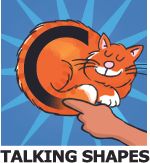
My youngest can write all his letters, but I have admittedly not spent as much time on handwriting with him as I did with his older siblings, so his handwriting can use some fine tuning. The Talking Shapes webpage explained that children draw letters onscreen to make three-letter words. Such activities, I felt, could help my youngest to see models of excellent handwriting and move closer to having beautiful printing himself.
My middle child knows the 40 speech sounds of English, but still struggles when decoding them and is not yet a confident and fluent reader. Even though it was immediately obvious to me that Talking Shapes was below her typical grade level, and perhaps, even her actual reading level, I felt that it might offer her a chance to feel confident and "shine" with simple reading, being the "expert" who could help her little brother should he ever get stuck with a lesson.
So, since all of my children loved the keyboarding program by Talking Fingers, I sat them down with the Talking Shapes webpage and asked them if they'd like to review it. They did. And, thus, we've spent the past month with the children testing the program out and, to my surprise, finishing all its levels.
My youngest child and nine-year-old were the primary users of Talking Shapes in our home. Their big brother sometimes sat with them and helped or played along with them just because he liked to. (Anything on screen that is anything game-like lures him over to the computer!) So, I thought I would let my youngest two tell you a bit about the program interview-style.
What is Talking Shapes?

Nina (9):
It's a story about two girls that made the alphabet. It teaches you how to write the upper case letters, what they sound like and how to make basic words.
Jack (6):
It is a computer game that teaches words and spelling.
Mom's Note Post-Interview:
The children summed up what the Talking Shapes is, but missed saying that it comes an iPad App, too. Since we do not have an iPad, they played it on our touchscreen laptop and are not aware that it can be used on tablets. When you purchase Talking Shapes, you get a one-year online subscription to access the program.
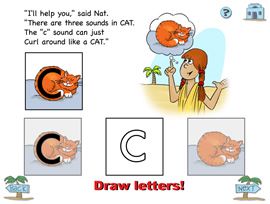
Also, I would like to add that as my youngest mentioned, the program does, indeed, only teach printed capital letters and their sounds. I had hoped it would include lower-case, too, since I am a strong believer in children learning lower-case letters before capital ones as most printed materials are, in lower-case letters.
What do you need to use Talking Shapes?
Nina:
A computer with internet connection. But, it does not even always work. It freezes and takes forever to load, or the game freezes, but nothing else on your computer does. Then, you have to restart the whole game.
Jack:
You need a computer. I could do it by myself after Mom helped me get on.
Mom's Note Post-Interview:
The program does, indeed, "freeze and take forever to load". At one point, I called the company about this because I had been waiting well over 15-minutes for it to come up on our computer. When I called, I was delighted to get a live, pleasant, and knowledgeable person on the end of the line right away. He explained that the program is still new and that my less-than-top-notch (my words not his) internet speed may be causing the slow load time. He explained how to quickly test our internet speed and, then, confirmed that our internet speed was likely the issue. I, then, explained that it had not been an issue with their keyboarding program or with any other programs we have used from other vendors, whereupon he explained that they are working on Talking Shapes to make it quicker and easier for all users, even those like me with slower connections. He also suggested clearing the cache on my computer, asked if I had further concerns, and suggested I call back anytime if I do.
Although not thrilled with the persistent slow loading times for Talking Shapes, then, I was pleased with their customer service in that I was able to get ahold of a love person right way and he proved personable and genuinely interested in helping.
The freezing up must be frustrating, Nina, but do you still like Talking Shapes?
Nina:
Yes. I like it, but it's kind of a little young for me. It sings the alphabet and does, "c-a-t" and "f-a-t", below my level. So, I didn't like it as much as Talking Fingers keyboarding, but I still liked it some.
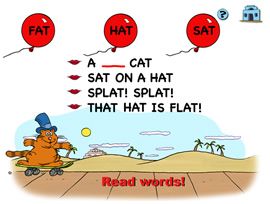
I liked that it was a good review and, for kids that are younger, it would be good for them - teaching. I felt like I knew a lot and I finished all seven books.
Did it give you confidence?
Nina:
Yes.
Mom's Note Post-Interview:
Confidence was a HUGE reason I chose to try this program with Nina. As a potential dyslexic, Nina often struggles with decoding and fluency when reading. Her struggle, in turn, becomes frustration, sadness, and upset. One of my goals at the beginning this summer, then, was to have Nina experience some of the same joy she does when I read to her when she is reading by herself. In short, I want her to begin to be as excited to read independent as she is to be read to and believe confidence plays a large part in experiencing such excitement.
Since Talking Shapes was easy for Nina yet still interesting enough to hold her attention, it did just what I hoped for: it built her confidence. There were no tears as she used the program and the only frustrations came when the program took a long time to load or froze during games. There were also smiles as Nina quickly made her way through each of the "books" of the program. Success!
What was your favorite part?
Nina:
The gamey part. You clicked on letters to make a word and you had to connect the letters to make a word, and, then, a machine popped something out.
Is there anything else you liked about it?
Nina:
Yes, at the end of each section when you build things out of parts.
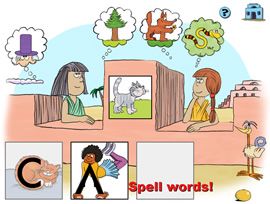
Jack:
I liked the doggie thingie where you move a dog and try to find the right word.
Jack, what do you think of the program overall?
Jack:
I did not learn much. It was too young for me. It gave me a little practice and was okay.
Mom's Note Post-Interview:
Jack was sick when I interviewed him and, thus, moody. So, although honest, his responses to my questions lack the enthusiasms he sometimes showed when using Talking Shapes. Often, when Nina had her turn on the computer with the program, Jack quickly went to sit right next to her. When she was done, he'd ask for his own turn. Then, his big brother would walk by and become interested in what was n the screen, and Jack would happily "teach" his big brother how to use the program. It was cute to see Jack so confident in what he was doing.
Final ThoughtsTalking Shapes offers a one-year subscription. If your children are truly new to phonemes, reading, and spelling, they might use this entire subscription period. However, if your children have some command of early literacy already or are "old" for Talking Shapes, as mine are, you may only need a small portion of your subscription time to move through the entire program. My children completed all of the Talking Shapes activities in less than a month.In doing so, my children reviewed:
- phoneme awareness
- phonics
- building basic words
- letter sounds
- letter shapes
- basic beginning spelling
They did this through:
- listening to stories
- viewing letters embedded in pictures
- drawing letters onscreen with guidelines and without (although sometimes they did not have to actually staying the guidelines for the letters to appear. Basically, they could scribble over the screen sometimes and still have it appear that they wrote the letters correctly.)
- playing games
- building words
Because Talking Shapes had slow load times and freezing issues on our computer, it was not as convenient as it could have been. However, the children still enjoyed using it and I would recommend it as something to check out for families with young children who like online learning and are just starting out with literacy skills or who would like to build confidence in them. I do so with the caveat that when using the program, you may want to bring it up on your computer, walk away and do something else until it loads, then come back and enjoy, expecting occasional freezing. (This is what we did.) I add a further note, however, that since since Talking Shapes has kind and helpful customer service agents, I a confident that they will have the slow loading and freezing quirks worked out soon and your experience with the program may, therefore, be more seamless than ours was.
Learn More

More than forty Schoolhouse Review Crew families reviewed Talking Shapes. Click through the banner above to read their thoughts.
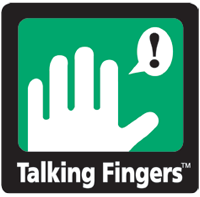
You can find Talking Finger, Inc. on Facebook, YouTube, and Twitter.





